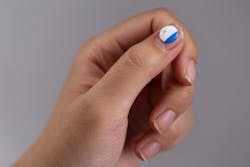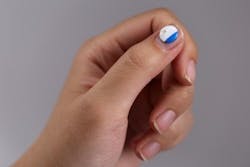Battery-free optical wearable device enables personalized phototherapy
Recognizing the need for a more-accurate and personalized way to measure light exposure, a team of researchers at the Northwestern University Feinberg School of Medicine and the Northwestern University McCormick School of Engineering (both in Chicago, IL) has developed a tiny wearable device that optically measures exposure to light across multiple wavelengths. What's more, the battery-free device can record up to three separate wavelengths of light at one time.
When the solar-powered, waterproof, and virtually indestructible device was mounted on human study participants, it recorded multiple forms of light exposure during outdoor activities, even in the water. The device monitored therapeutic ultraviolet (UV) light in clinical phototherapy booths for psoriasis and atopic dermatitis, as well as blue light phototherapy for newborns with jaundice in the neonatal intensive care unit. It also demonstrated the ability to measure white light exposure for seasonal affective disorder (SAD).
As such, it enables precision phototherapy for these health conditions, and it can monitor, separately and accurately, UVB and UVA exposure for people at high risk for melanoma, a deadly form of skin cancer. For recreational users, the sensor can help warn of impending sunburn.
"From the standpoint of the user, it couldn't be easier to use—it's always on yet never needs to be recharged," says John Rogers, the Louis Simpson and Kimberly Querrey Professor of Materials Science and Engineering, Biomedical Engineering in the McCormick School of Engineering and a professor of neurological surgery at Northwestern's Feinberg School of Medicine, whose group developed the device. "It weighs as much as a raindrop, has a diameter smaller than that of an M&M, and the thickness of a credit card. You can mount it on your hat or glue it to your sunglasses or watch."
The UVA sunlight skin sensor is shown applied on fingernail. (Photo credit: Northwestern University)
"We hope people with information about their UV exposure will develop healthier habits when out in the sun," says co-senior author Dr. Steve Xu, instructor in dermatology at Feinberg and a Northwestern Medicine dermatologist. "UV light is ubiquitous and carcinogenic. Skin cancer is the most common type of cancer worldwide. Right now, people don't know how much UV light they are actually getting. This device helps you maintain an awareness and for skin cancer survivors, could also keep their dermatologists informed."
"Being able to split out and separately measure exposure to different wavelengths of light is really important," Rogers says. "UVB is the shortest wavelength and the most dangerous in terms of developing cancer. A single photon of UVB light is 1000 times more erythrogenic, or redness-inducing, compared to a single photon of UVA."
Currently, the amount of light patients actually receive from phototherapy is not measured. "We know that the lamps for phototherapy are not uniform in their output—a sensor like this can help target problem areas of the skin that aren't getting better," Xu says. Doctors don't know how much blue light a jaundiced newborn is actually absorbing or how much white light a patient with seasonal affective disorder gets from a light box. The new device will measure this and allow doctors to optimize the therapy by adjusting the position of the patient or the light source.
Because the device operates in an "always on" mode, its measurements are more precise and accurate, the scientists say. Current dosimeters only sample light intensity briefly at set time intervals and assume that the light intensity at times between those measurements is constant, which is not necessarily the case, especially in active, outdoor-use scenarios. They are also clunky, heavy, and expensive.
Light passes through a window in the sensor and strikes a millimeter-scale semiconductor photodetector. This device produces a minute electrical current with a magnitude proportional to the intensity of the light. This current passes to an electronic component called a capacitor, where the associated charge is captured and stored. A communication chip embedded in the sensor reads the voltage across this capacitor and passes the result digitally and wirelessly to the user's smartphone. At the same time, it discharges the capacitor, thereby resetting the device.
Multiple detectors and capacitors allow measurements of UVB and UVA exposure separately. The device communicates with the users' phone to access weather and global UV index information (the amount of light coming through the clouds). By combining this information, the user can infer how much time they have been in the direct sun and out of shade. The user's phone can then send an alert if they have been in the sun too long.
Called "My Skin Track UV," the UVA version of the platform is now commercially available from L'Oreal.
Full details of the work appear in the journal Science Translational Medicine.

